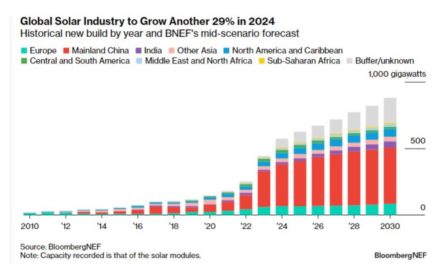- BNEF’s latest report says tripling renewable energy capacity to 11 TW by 2030 is an achievable goal
- Solar alone can help achieve it, but to address global carbon emissions a balanced growth of other renewable energy sources is also required
- Economics is not holding renewables back, but individual countries need to see how they wish to contribute to this global goal
The call by the COP28 presidency to triple global renewable energy capacity to 11 TW by 2030, from 3,600 GW in 2022, can be achieved by solar alone as it is ‘cheap and easy,’ according to the Bloomberg New Energy Finance (BNEF). However, to achieve a positive climate impact, it is important to push other renewables as well.
Even though it is the cheapest source of bulk electricity and is easy to install, solar has a low capacity factor and high seasonality. To address global carbon emissions, the world needs a balanced deployment of clean power technologies, especially wind, to achieve the 11 TW goal which analysts believe is in line with what’s needed for a net-zero pathway by 2050 and is very much doable.
“BNEF’s forecasts suggest that the required growth in solar is already on track to be achieved, while the required wind build will require concerted action to unlock,” says BNEF in its report Tripling Global Renewables by 2030: Hard, Fast and Achievable, while recommending a global concerted push towards diversifying renewable energy sources.
It took the world 12 years to triple its renewable energy capacity the last time round with cost reduction and favorable policies, says BNEF, but this time it needs to take 8 years. According to the market intelligence firm, the proposed pledge matches what is needed for a global net-zero pathway by 2050 and Paris-aligned climate goals.
Investment
The global rate of investment in renewable energy needs to be increased to an average of $1,175 billion/year between 2023 and 2030, from $564 billion in 2022. However, economics is generally not what is holding renewables back, stresses BNEF, and deploying more can benefit regions with rapidly rising electricity demand.
Geographical share
According to the analysts, this 11 TW global goal can be achieved with individual parties determining how they can contribute. For earlier adopters of renewable energy such as the US, Europe, Japan and China, tripling is the right goal to set domestically as it would align with a net-zero pathway based on BNEF’s scenario modeling.
Other countries may need to do less if they already have a high amount of renewable energy in the mix like Brazil. In such regions, efforts should be directed at decarbonizing industry, buildings, transport, agriculture, etc.
Solutions
Governments around the world also need to address some barriers to tripling the renewable energy capacity. The report writers identify the solutions as the following:
- Increase access by removing fossil fuel subsidies, easing licensing for renewable energy and storage projects generation, and clarifying land ownership rights especially in emerging and developing economies
- Auctions and offtakes to incentivize renewables deployment. These should be designed to de-risk projects, diversify energy mix and encourage corporations to sign power purchase agreements (PPA), and mitigate offtaker risk.
- Grids and infrastructure capacity should be expanded by creating central plans for grid expansion, including interconnectors, enable anticipatory grid investment, encouraging private sector participation to modernize infrastructure and managing grid queues effectively. Currently, BNEF says it can take up to 8 years for a project to get a grid connection permit in Europe, which means a 2023 project cannot come online to meet the COP28 target. At the end of 2022, close to 600 GW of renewables were in connection queues of 5 key European states. In the US, projects in grid queues are enough to triple the country’s renewables capacity by 2030.
- Permitting is another issue that can delay projects significantly hence need to streamline permitting processes with one-stop-shop for applications with increased digitalization to enable information sharing between departments.
- Effective power market design by setting long-term targets, competitive price signals for capacity and dispatch to enable renewables integration.
“Renewables are low-cost, and direct subsidy is no longer what is needed to speed up deployment,” said BNEF’s Head of Clean Power and co-author of the report, Meredith Annex. “Governments and regulators have a limited window of time to help the industry get on track.”
The complete report is available for free download on BNEF’s website.















